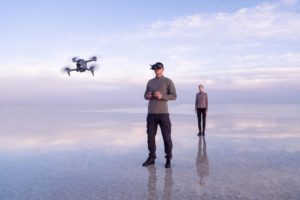
Chinese drone giant DJI is flying into a new drone category with the announced release today of the DJI FPV.
According to a corporate release, the new model combines:
- “The first-person view and high-speed performance of racing drones
- The cinematic camera sweep of traditional drones
- The safety and transmission technology of DJI’s leading consumer drones
- An optional, single-handed motion controller that allows pilots to control the drone with just hand movements.”
“DJI has been redefining what drones can do since our company began in 2006, and as we celebrate our 15-year anniversary this year, we honor that heritage of innovation by redefining what drone flight can be with DJI FPV,” said Ferdinand Wolf, Creative Director, DJI Europe.
“Right out of the box, DJI FPV combines the best available technology for a hybrid drone like no other. It can fly like a racer, hover like a traditional drone, accelerate like a homebuilt project and stop faster than any of them. DJI FPV lets the world experience the absolute thrill of immersive drone flight without being intimidated by the technology or spending hours building a system from scratch. We can’t wait for the world to try it.”
The new FPV system allows pilots to see from the drone’s perspective in low-latency high definition thanks to O3, the third iteration of DJI’s proprietary OcuSync technology that can capture 4K video at 60 fps with the assistance of RockSteady electronic image stabilization.
Newly designed motors bring a racing experience to the DJI FPV with a max speed of 87 mph and a max acceleration of 0-62 mph in two seconds.
Flight modes
The DJI FPV features three flight modes:
- Normal (N) Mode: During N mode operation, DJI FPV operates similar to other DJI drones, hovering in place with the use of GPS and/or visual positioning systems (VPS) on the bottom of the drone. The most approachable flight mode, N mode allows for obstacle detection sensors on the front to be activated to warn when obstacles are near and slow down. Pilots are tasked with maneuvering the drone away from any detected obstacles.
- Manual (M) Mode: Take full control over the drone with M mode which is designed for more experienced users. While in M mode, all sensors and hovering features are disabled.
- Sport (S) Mode: A new hybrid blend of M and N mode, S mode offers some of the dynamic movement capabilities that come with M mode along with some of the key safety features of N mode. S mode is the middle step between the three modes and developed to give pilots more room to explore their skills as they get accustomed to FPV flight.
Viewing options
- High-Quality Mode: See the world in 1440x810p in either 60 fps with a wider 142° Field of View (FOV), or 50 fps with 150° FOV. In this mode, latency is as low as ≤ 40 ms.
- Low-Latency Mode: In this mode, pilots activate high frame rates for a more cinematic look to signal latency is decreased to ≤ 28 ms. Resolution is 1440×810p 120 fps with a 142° FOV or 100 fps at 150° FOV.
- Audience Mode: Share the pilot’s perspective in audience mode, which connects up to eight additional goggle sets to the pilot’s view so even onlookers can experience the flight.
The standard FPV Combo includes the drone, remote controller, FPV Goggles V2, all required cables and one battery for the retail price of $1,299.
The new model release comes at a time of some turbulence for the drone manufacturer. Last week, DJI laid off workers at its Pal Alto R&D office. As noted in a previous DroneLife report:
“Earlier this year some high profile DJI executives based in the U.S. moved on to other opportunities, including VP of North America Mario Rebello and Public Safety expert Romeo Durscher. The changes could be simply restructuring due to company maturity or the effects of the pandemic, or they may be a result of ongoing pressure from the U.S. government for government agencies to move away from Chinese-manufactured technology. Ongoing arguments over the use of foreign manufactured drone platforms have led to confusion in the marketplace, even for customers not receiving any government funding, and the U.S. government has thrown support behind domestic drone platforms.”
Miriam McNabb contributed to this report.
Jason is a longstanding contributor to DroneLife with an avid interest in all things tech. He focuses on anti-drone technologies and the public safety sector; police, fire, and search and rescue.
Beginning his career as a journalist in 1996, Jason has since written and edited thousands of engaging news articles, blog posts, press releases and online content.
Email Jason
TWITTER:@JasonPReagan
Subscribe to DroneLife here.